How to make the fly traps
Materials
To construct the traps detailed on our flytrap project page you will need:
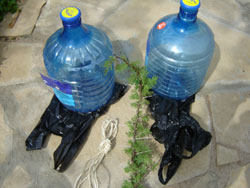 two same-sized, empty, drinking-water bottles. Those shown are 10 litre
capacity, but 5 litres or even 1.5 litre bottles work perfectly well
two same-sized, empty, drinking-water bottles. Those shown are 10 litre
capacity, but 5 litres or even 1.5 litre bottles work perfectly well- two black polythene bags (found absolutely everywhere in Kenya & Tanzania)
- some sisal string or cloth strips
- six large acacia thorns found almost everywhere
- a sharp pointy knife or blade
Construction
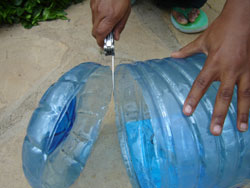 To make the top section of the trap, slice the bottom off of one of
the bottles. If the bottle is ribbed, best to cut at the lower edge of one
of the raised ribs, rather than in the grooves. This helps with fixing
firmly on the bottom section of the trap later.
To make the top section of the trap, slice the bottom off of one of
the bottles. If the bottle is ribbed, best to cut at the lower edge of one
of the raised ribs, rather than in the grooves. This helps with fixing
firmly on the bottom section of the trap later.
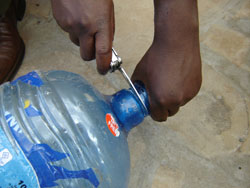 Cut the excess neck from the second bottle. The plastic here is quite
thick and it takes a fair bit of effort to do this. Heating an old knife
in a fire might help, though burning the plastic with a knife that was too
hot may cause a burnt plastic chemical smell which might deter flies from
passing through.
Cut the excess neck from the second bottle. The plastic here is quite
thick and it takes a fair bit of effort to do this. Heating an old knife
in a fire might help, though burning the plastic with a knife that was too
hot may cause a burnt plastic chemical smell which might deter flies from
passing through.
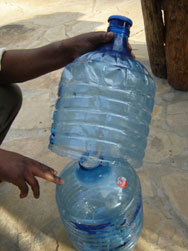 Place the first cut bottle over the second whole bottle. It should
sit very snugly, especially if care was taken over the cutting. Ideally
there will be 5-10mm where the plastic sides of the top bottle are flush
with the curving top of the bottom bottle and this is where holes will be
drilled through the plastic of both bottles to insert the thorns for
fixing. If the top bottle was not ribbed, then slits can be cut vertically
in the top bottle and this will allow it to push snugly over the bottom
bottle.
Place the first cut bottle over the second whole bottle. It should
sit very snugly, especially if care was taken over the cutting. Ideally
there will be 5-10mm where the plastic sides of the top bottle are flush
with the curving top of the bottom bottle and this is where holes will be
drilled through the plastic of both bottles to insert the thorns for
fixing. If the top bottle was not ribbed, then slits can be cut vertically
in the top bottle and this will allow it to push snugly over the bottom
bottle.
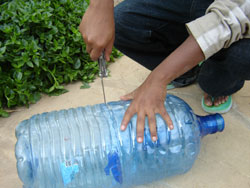 Lay the two bottles on their sides, and with the tip of a sharp pointy
knife "drill" about six very small holes through both walls of
the bottles, evenly spaced around the edge. This should be done where the
top bottle sits flush and snugly on the bottom bottle. Don't press too
hard, and twist the knife rigorously, so it will "drill" a hole
rather than cut a slit. Only make very small holes as pushing the acacia
thorns through later will enlarge them as necessary to hold tightly.
Lay the two bottles on their sides, and with the tip of a sharp pointy
knife "drill" about six very small holes through both walls of
the bottles, evenly spaced around the edge. This should be done where the
top bottle sits flush and snugly on the bottom bottle. Don't press too
hard, and twist the knife rigorously, so it will "drill" a hole
rather than cut a slit. Only make very small holes as pushing the acacia
thorns through later will enlarge them as necessary to hold tightly.
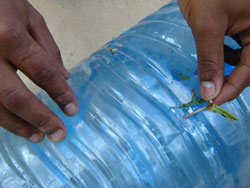 Using a single large acacia thorn, with a little of the base bark
still attached, push through the pre-drilled holes
Using a single large acacia thorn, with a little of the base bark
still attached, push through the pre-drilled holes
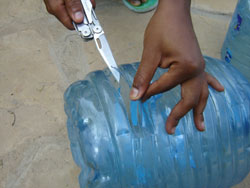 Cut two or three entry slit "windows" around the base of the
bottom bottle. They should be cut about 30 mm up from the bottom with an
overhanging "flap". The openings should be about 10-12 mm deep
and 50 - 60mm across. They should be cut on three sides, and folded out
along the top edge - see detail below.
Cut two or three entry slit "windows" around the base of the
bottom bottle. They should be cut about 30 mm up from the bottom with an
overhanging "flap". The openings should be about 10-12 mm deep
and 50 - 60mm across. They should be cut on three sides, and folded out
along the top edge - see detail below.
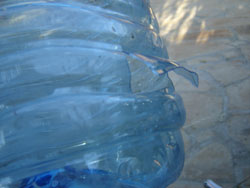 Detail of the entry-slit opening. Fold the "flap" out along
its top edge. When the flap (but not the hole) is covered by the black
polythene bags it deters flies from exiting through the entry slit. It
will also prevent rainwater from running into the trap and causing the
bait to overflow.
Detail of the entry-slit opening. Fold the "flap" out along
its top edge. When the flap (but not the hole) is covered by the black
polythene bags it deters flies from exiting through the entry slit. It
will also prevent rainwater from running into the trap and causing the
bait to overflow.
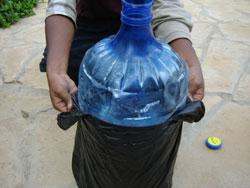 Cover the bottom section of the trap bottles with double thickness black
polythene bags, including the base. In this case the bags fit fairly snugly over the bottom
bottle. Fold the bags back on themselves if necessary so that the whole of
the bottom bottle is darkened, leaving the top bottle clear and light.
They can be tied in place with string or cloth strips if necessary.
Cover the bottom section of the trap bottles with double thickness black
polythene bags, including the base. In this case the bags fit fairly snugly over the bottom
bottle. Fold the bags back on themselves if necessary so that the whole of
the bottom bottle is darkened, leaving the top bottle clear and light.
They can be tied in place with string or cloth strips if necessary.
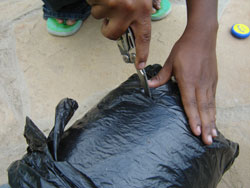 Locate the pre-cut entry slits in the bottom bottle and cut away the
black polythene bag where it covers the holes. If the bags are loose
fitting, you may need to remove a small amount of black polythene to allow
clear access room for flies to enter the slit, but
don't remove so much polythene that there is not enough to cover the
overhanging flap. This helps keeps the bottom dark and deters flies
from leaving through the entry slits.
Locate the pre-cut entry slits in the bottom bottle and cut away the
black polythene bag where it covers the holes. If the bags are loose
fitting, you may need to remove a small amount of black polythene to allow
clear access room for flies to enter the slit, but
don't remove so much polythene that there is not enough to cover the
overhanging flap. This helps keeps the bottom dark and deters flies
from leaving through the entry slits.
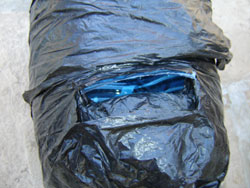 Not the best pic I'm afraid but it does show the entry slit and the flap
still covered by black polythene.
Not the best pic I'm afraid but it does show the entry slit and the flap
still covered by black polythene.
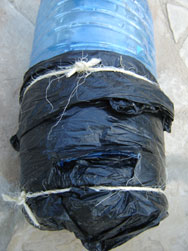 Sisal string (or cloth strips) can be used to hold the polythene bags in
place. Again this is a bit messy and could be neater with a little
more time spent on construction.
Sisal string (or cloth strips) can be used to hold the polythene bags in
place. Again this is a bit messy and could be neater with a little
more time spent on construction.
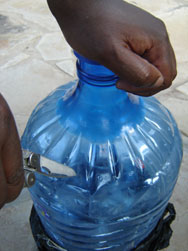 With the tip of a knife drill a few air ventilation holes in the top
bottle. Obviously don't make these large enough so the flies could escape.
This prevents condensation in the top bottle (which may prolong the life
of the flies if they drink the water), and even cause them to rot rather
than simply dehydrate. It also keeps the air in the top bottle relatively
"fresh" to ensure flies are not put off from entering by high
concentrations of unfavourable gasses or maybe low concentrations of
oxygen.
With the tip of a knife drill a few air ventilation holes in the top
bottle. Obviously don't make these large enough so the flies could escape.
This prevents condensation in the top bottle (which may prolong the life
of the flies if they drink the water), and even cause them to rot rather
than simply dehydrate. It also keeps the air in the top bottle relatively
"fresh" to ensure flies are not put off from entering by high
concentrations of unfavourable gasses or maybe low concentrations of
oxygen.
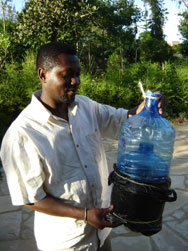 Another length of string can be tied around the neck of the bottle for
hanging. Now carefully pour in milk, meat scraps, food scraps,
sugary water (it doesn't matter if some spills or gets spread around the
entry slits - just adds to the attractiveness) and VOILA!
Another length of string can be tied around the neck of the bottle for
hanging. Now carefully pour in milk, meat scraps, food scraps,
sugary water (it doesn't matter if some spills or gets spread around the
entry slits - just adds to the attractiveness) and VOILA!
Hang somewhere off the ground so it isn't knocked over by children, animals or wind. Empty, clean and check bait after every 3 or 4 days.
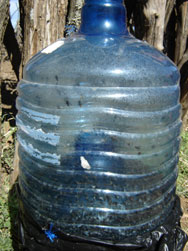
Thousands of flies caught in a 10 litre bottle trap after two days in a Maasai boma. Maybe enough chicken food there to convert into 1 egg! Now that's recycling sustainable fly harvesting .... mmm tasty......